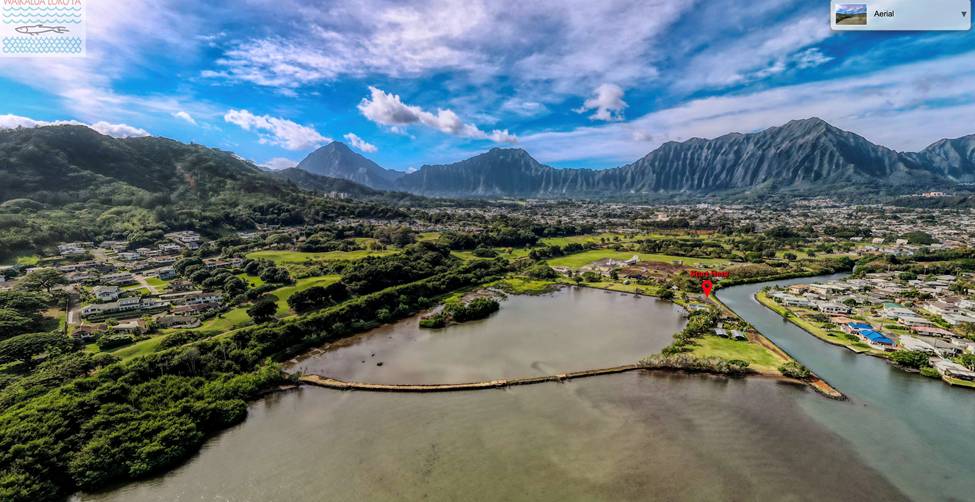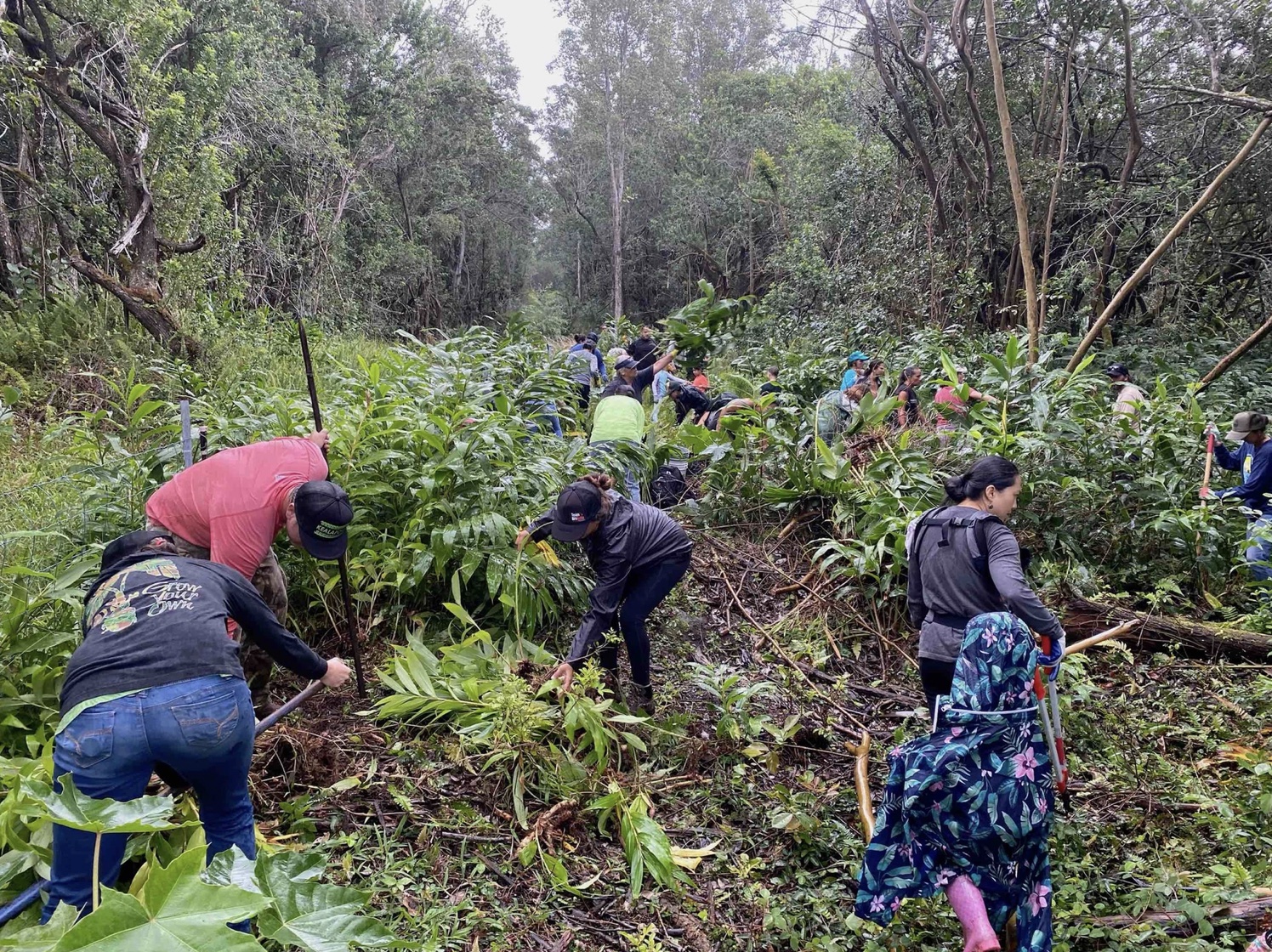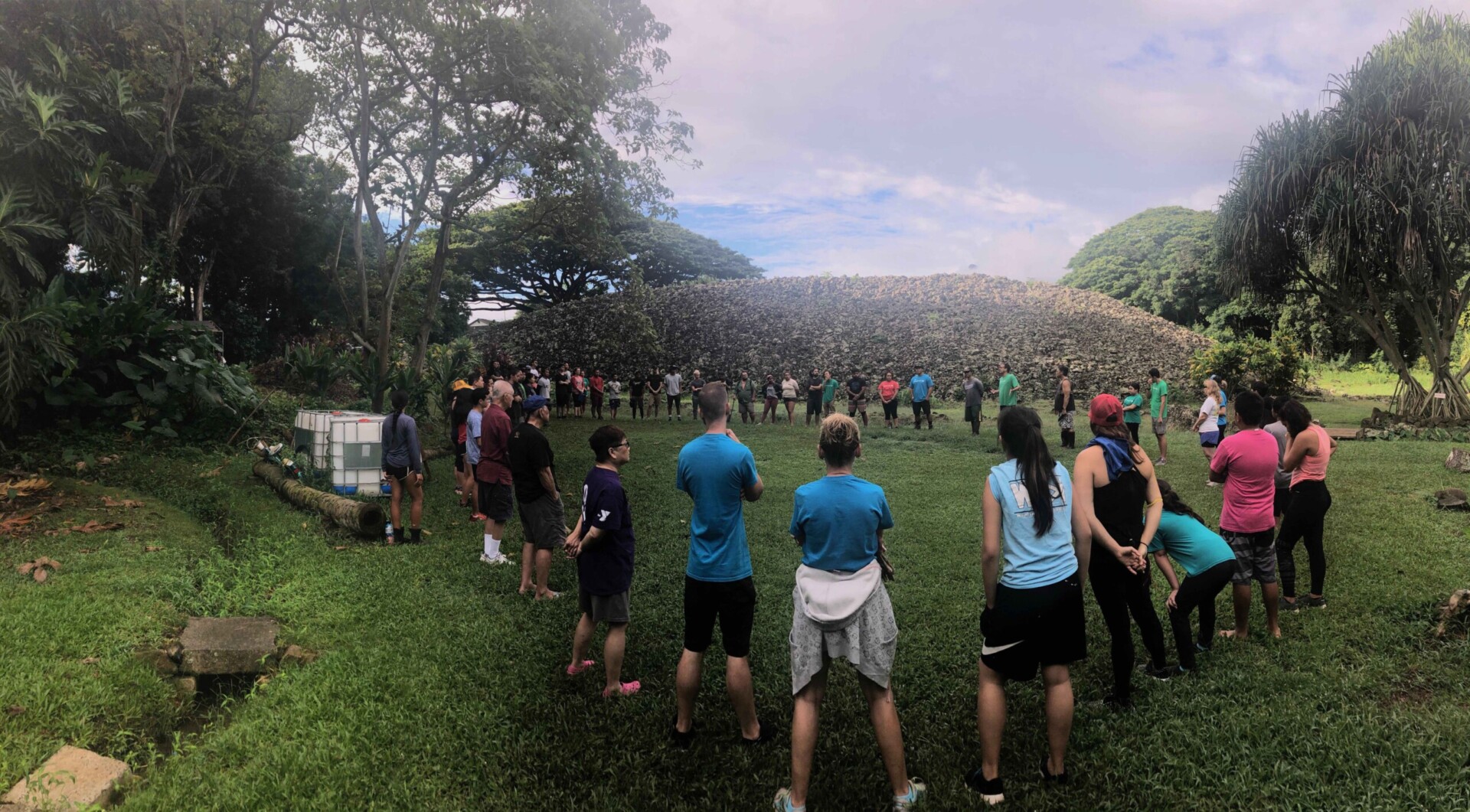In October 2022, Historic Hawai‘i Foundation announced the first partners in its Native Hawaiian Organization Stewardship Training Program.
The NHO Stewardship Program is a five-year initiative between HHF and the U.S. Department of the Interior to build capacity of NHOs towards historic preservation and stewardship with the goal of ensuring that their traditional cultural stories and places are being documented, preserved and shared in an appropriate manner with visitors and residents. The program is also supported by a Kūkulu Ola grant from the Hawai‘i Tourism Authority. (See additional details at the end of this article.)
HHF Executive Director Kiersten Faulkner said that the first cohort of NHO Partners includes three projects which will be conducted over the next 18 months.
Project 1: Kauluakalana was selected for a stewardship training, preservation and restoration project at Ulupō Heiau State Historic Site in Kailua, O‘ahu.
Ulupō Heiau State Historical Park consists of 28 acres along the eastern side of Kawainui Marsh. The majestic heiau encompasses approximately 1.42 acres and is the primary feature within the park boundaries. Secondary features include stone walls and enclosures from both the pre-contact and post-contact periods. The landscape has been modified by vegetation clearing, restoring lo‘i kalo (taro) and ‘auwai (traditional irrigation ditch) and planting Polynesian-introduced plants. The heiau is listed in the Hawai‘i Register of Historic Places.
Kauluakalana has worked under the nonprofit organization Hika‘alani, which has a Curatorship Agreement with the State of Hawai‘i Department of Land and Natural Resources for the stewardship of the heiau and cultural landscape. The Native Hawaiian Organization uses a three-pronged approach of mo‘olelo (history, tradition), hana (work) and hānai (foster, sustain) to involve community members in activities to restore and grown healthy kānaka-‘āina relationships that provide for authentic, respectful and culturally-grounded visitation.
The project supported by the Historic Hawai‘i Foundation program will include conducting monthly workdays (12 total) that include ‘āina meals from Kūkanono; conduct 48 ‘āina learning experiences (four/month); create an internship program and support two interns; clear invasive weeds and map 100 square feet of the heiau rock structure; remove 200 square feet of invasive vegetation from the Kawainui fishpond; plant and harvest eight lo‘i.
Project 2: Pacific American Foundation was selected for a stewardship training, preservation and restoration project at Waikalua Loko I‘a in Kāne‘ohe, O‘ahu.

Aerial photo of Waikalua Fishpond. Photo by D. Esibill, courtesy Pacific American Foundation.
Aerial photo of Waikalua Fishpond. Photo by D. Esibill, courtesy Pacific American Foundation.
Waikalua Loko I‘a is located in the southern end of Kāne‘ohe Bay and is surrounded by two streams: Kāne‘ohe and Kawa. Waiakalua is a complex of two fishponds on either side of Kawa Stream. The kuapā (enclosure) wall is approximately 800 feet long and has three ‘auwai (water passages) that both fill and empty water from the bay. The fishpond is about 17 acres, with approximately 12 acres underwater. Hawaiian fishponds were on the verge of vanishing from the landscape in the last century. Approximately 488 fishponds were built in the major islands from 800 years ago and fewer than 15% remain. These fishponds provided a food source for Hawaiian prior to western contact and represent a feat of engineering that was unique in the world.
Pacific American Foundation was founded by Native Hawaiians to provide social, economic, cultural and educational opportunities. Efforts to restore Waiakalua began in 1995 and the stewardship of the fishpond is core part of the organization. Programs include educational, mentorship, leadership and stewardship programs that link indigenous wisdom with contemporary knowledge to meet current challenges.
The project supported by HHF will include conducting maintenance and preservation activities at the historic fishpond via hiring and training 25 stewardship leaders; holding five online/in-person training workshops; conducting five community work days; and coordinating community education and cultural visits throughout the year.
Project 3: Huliauapa‘a was selected for a stewardship planning and training project at Kahalu‘u Kūāhewa, a segment of the Kona Field System, Kahalu‘u, Hawai‘i Island.

Wahi kūpuna work day at Kahalu‘u Field System. Photo by Kimbery Kahoonei, courtesy Huliauapaa.
Wahi kūpuna work day at Kahalu‘u Field System. Photo by Kimbery Kahoonei, courtesy Huliauapaa.
The Kona Field System once spanned 35,000 acres of prime agricultural land. Today, much of it has been transformed into non-native plantation crops. Kahaluʻu Kūāhewa is a kahiko (ancient) Hawaiian engineered agricultural field system consisting of terraced and irrigated fields and gardens; temporary and permanent habitations; sacred spaces; and, footpaths, roads, and trail systems ensconced within a greater biocultural landscape extending from mauka (inland) to makai (coast, sea) and beyond. It served as the mauka breadbasket for Kona kahiko (ancient Kona). It is one of Konaʻs largest intact traditional agricultural field systems.
Huliauapaʻa is a Native Hawaiian organization whose purpose is to educate and empower Native Hawaiian students, communities, and professionals about the stewardship of Hawaiʻi’s wahi kūpuna (ancestral places). Its mission is growing communities through culturally-based forms of innovative learning, leadership development, and collaborative networking in wahi kūpuna stewardship.
The project supported by HHF is to generate a Stewardship Plan Template for utilization at Kahaluʻu Kūāhewa and other locations throughout the archipelago and conduct stewardship trainings supporting increased visitation and the recognition of Wahi Kūpuna Best Management Practices.
In the news…
Hawaii Public Radio’s Culture & Arts Reporter, Jayna Omaye, talks to NHO program stewards.
Partnering With Native Hawaiian Organizations on Stewardship Training For Site Protection and Restoration: Program Background
In 2022, Historic Hawai‘i Foundation launched a new program to partner with Native Hawaiian Organizations on hands-on stewardship training for the preservation of historic and cultural sites that are significant to Native Hawaiian organizations and communities. The agreement supports building the capacity of NHOs towards historic preservation and stewardship with the goal of ensuring that their traditional cultural stories and places are being documented, preserved and shared in an appropriate manner with visitors and residents alike.
The five-year program is the result of a partnership with the U.S. Department of the Interior’s National Park Service and Office of Native Hawaiian Relations, with funding through the Bureau of Indian Affairs. In September 2021, NPS added $450,000 to HHF’s on-going project for Historic Preservation Training in the Hawaiian Islands. The additional funds were provided through the Native American Tourism & Improving Visitor Experience (NATIVE) Act that was passed by Congress in 2016 to establish a more inclusive national travel and tourism strategy with the potential to deliver significant benefits for Native Hawaiians, including jobs creation, elevated living standards and expanded economic opportunities.
The training units will be implemented in partnership with the Native Hawaiian Organizations (NHO) for preservation of the selected cultural sites. Field work at their respective historic sites to preserve and restore places that are significant to the culture, traditions, and practices of the Native Hawaiian Community will be included.
NHO Partner Selection Process
The selection process began in 2021 with initial program scoping and a development phase to establish NHO solicitation parameters, evaluation criteria, and regulatory compliance requirements. NHO solicitation, review and selection were done in 2022. It is expected that NHO solicitations will occur on a recurrent basis and that multiple NHO across the State will be engaged through 2026.


